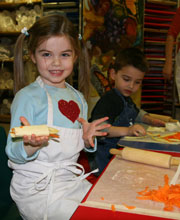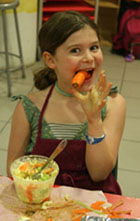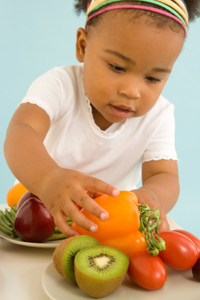 When I first started teaching cooking classes to kids, there was an adorable 4 year old girl who didn't want to help. While preparing the ingredients to make bread, I handed her the yeast mixture. She sniffed it suspiciously while adding it to the flour - but after a few minutes of stirring them together, she looked up at me with her eyes wide and full of excitement and exclaimed, "We're making dough!" I watched her make that first connection between raw ingredients and a familiar food.
When I first started teaching cooking classes to kids, there was an adorable 4 year old girl who didn't want to help. While preparing the ingredients to make bread, I handed her the yeast mixture. She sniffed it suspiciously while adding it to the flour - but after a few minutes of stirring them together, she looked up at me with her eyes wide and full of excitement and exclaimed, "We're making dough!" I watched her make that first connection between raw ingredients and a familiar food.
She was entranced when the bread came out of the oven and proudly took it home to her family. I was hooked - that was over twelve years ago and I've been teaching kids and parents how to cook ever since.
It's hard to find time to share a family meal these days. Yet many adults will tell you that some of their strongest childhood memories are sitting around the dinner table. These meaningful connections between family and food become even more powerful when children are involved in the meal preparation.
After learning a few fundamentals on how to cook with kids, even the busiest parents can carve out a couple of hours each week and develop a ritual of cooking together as a family. Although it can sound like a chaotic project to many parents, the rewards are many - especially when they become old enough to cook you dinner....
For more information about cooking with kids and children's nutrition, check out my blog. For a list of past blog posts, visit the Recipes and Info page.
![]()
COOKING WITH KIDS
Kids in the Kitchen - Your Little Sous Chefs Can Help You Throw a Dinner Party
Next time you’re having guests over, ask your kids to help. It can be hard to figure out what’s safe for them to do in the meal preparation but there are plenty of tasks that don't involve sharp tool. Sit them at the dinner table and bring the projects to them while you bustle around the kitchen. They'll get a kick out of mashing and cracking while you attend to the important head chef duties.
They can helping with:

WASHING fresh herbs or lettuce in the sink and then drying in a salad spinner or wrapping in a towel.
CRACKING eggs into a large bowl. Kids as young as 2 master this skill very quickly and love to do it. Just make sure they wash their hands well afterwards.
WHISKING is a favorite task for kids and is safe for any age group.
RIPPING fresh herbs into small pieces so you don't have to chop them.
MASHING with a fork or potato masher is always a favorite task for every age group.
BRUSHING dishes with butter, milk, oil or an egg wash.
SCOOPING the flesh out of foods like sweet potatoes or eggplant.
For the kids who aren’t interested in helping with food preparation, have them:
SET THE TABLE and let them add some decorations or arrange flowers in a vase.
MAKE PLACEMATS for the children who are attending as guests.
GARNISH the finished dishes using fresh herbs or edible flowers – which is perfect for artistic children.
FOLD NAPKINS and come up with creative ways to make napkin rings or tie with a ribbon.
CLEAN UP the house and kitchen – many kids don’t have chores these days but you'd be surprised how many of them actually enjoy tasks like wiping down the kitchen table with a sponge (take advantage of this while you can).
Looking for new recipes you can make with your kids? Check out my blog, My Kitchen Nutrition, for family-friendly recipes.
Have fun!
READ this letter from the parent of Julie's student who went from picky eater to budding chef...
![]()
NUTRTITION FOR KIDS
It’s hard to find time for the entire family to schedule regular meals together. Erratic work schedules and jam-packed after school activities make it very challenging for the entire family to sit at the dinner table during the week. However, the benefits of eating together are many. Studies show that sharing several meals per week can improve children’s vocabulary, test scores, and athletic performances. They are more likely to eat more fruits and vegetables and weigh less than children who rarely share a family meal. Older children and teens are more likely to confide in a parent, less likely to get in trouble at school. and get good grades.
For families who have very busy weeks, it's often easier to gather everyone together on a weekend night. Borrow a tradition from the Jewish religion and gather your family around the dinner table every Friday evening. Create rituals like lighting candles or sharing something good that happened that week. Make breakfast together on weekend mornings and invite family members over for Sunday night dinners.
For parents with small children who need to eat early while one spouse is still at work, try partaking in a starter like a salad or soup with the children. It gives you an opportunity to eat something healthy in front of them and model good eating habits and manners. Try to have at least one dinner in the middle of the week with the entire family even if it’s a simple meal of scrambled eggs, toast and a green salad. It doesn’t have to be gourmet in order to be meaningful.
![]()
There is a lot you can in your community to improve our food and our children's school food. Visit these sites to learn more about what you and our family can do to participate in the Food Revolution.
www.foodsecurity.org (Dedicated to Building Strong Reginoal Food Systems)
www.realfoodchallenge.org (Building a School Movement to Transform our Food Economy)
www.schoolfoodfocus.org (Transforming Food Options for Children in Urban Schools)
Do you want to start a School Wellness Program at your local school?
Visit www.schoolwellnesspolicies.org or www.healthiergeneration.org for information. There is plenty of funding but many schools still don't have program or need help in expanding their programs.
Brief description of School Wellness Programs:
In the Child Nutrition and WIC Reauthorization Act of 2004, the U.S. Congress established a new requirement that all school districts with a federally-funded school meals program develop and implement wellness policies that address nutrition and physical activity by the start of the 2006-2007 school year [Section 204]. In response to requests for guidance on developing such policies, the National Alliance for Nutrition and Activity (NANA, www.nanacoalition.org) convened a work group of more than 50 health, physical activity, nutrition, and education professionals from a variety of national and state organizations to develop a set of model policies for local school districts.
![]()




